According to the American Medical Association and the Nemours Foundation, the majority of sports injuries are preventable. The following are some helpful guidelines for protecting your child from experiencing a sports-related injury. Click here to learn more about preventing injuries on the playground.
General guidelines
Fit gear appropriately
Make sure the equipment is carefully fitted for your child and that they wear safety gear appropriate for the sport.
Protect the mouth and face
The National Institute of Dental and Craniofacial Research sites that only 35 percent of softball and baseball players wear protective head gear, and 7 percent of soccer players wear head protection. Protective head and mouth gear greatly reduces the chance of experiencing sports-related dental and facial injuries.
Purchase high-quality equipment
Purchase helmets with polycarbonate shields for bicycle riding, baseball, softball and hockey. Use polycarbonate goggles for basketball and other court games. Make sure knee, elbow, shoulder and wrist pads are well-constructed and durable.
Inspect equipment
If your child uses school equipment, ask the coach about helmets, mouthgear, headgear and padding. Find out if it's approved by a certifying organization. All equipment should have safety features and should be properly maintained.
Maintain playing surface
Check the surface of fields for low areas and places where a child could stumble or fall. Watch for water spots on courts. Make sure children are not playing on concrete; an injury on concrete can be severe.
Supervise
Always have qualified adult supervision during sports and outside activities. Make sure they are trained in first aid and CPR. Your child's coach should commit to the safety of your child at the same level that you do. Supervisors must enforce rules of the game as well as the use of safety equipment. Also, children should be equally matched in sports according to size and skill level, etc.
Prepare
A child needs coaching and practical experience before he or she can play team sports. At-home practice, lessons and warm-ups should be performed before sporting activities begin. Introduce sports to your child in a casual setting, or encourage neighborhood play activities, and do not pressure your child to become involved in sports before they are ready.
Sport-specific guidelines
Soccer
Soccer is one of the most popular sports in the world and is generally perceived as a safe sport. The most common soccer-related injuries are sprains, strains and bruising to the lower leg, ankle and foot. These incidents occur more often in girls than boys and in indoor soccer rather than outdoor soccer.
Safety tips for playing soccer:
- Shin guards - This protective gear should always be worn while playing soccer and helps protect against leg fractures.
- Shoe considerations - Molded cleats or ribbed soles are more effective at preventing injury than removable spikes. Wear proper footwear depending on the surface of the playing field to avoid sliding and falling.
- Ball considerations - The heaviness of leather balls makes them more likely to cause an injury than waterproof, synthetic balls.
- Eye protection (polycarbonate lenses) and mouthguards - Helps prevent injury to the face area
Bicycle
riding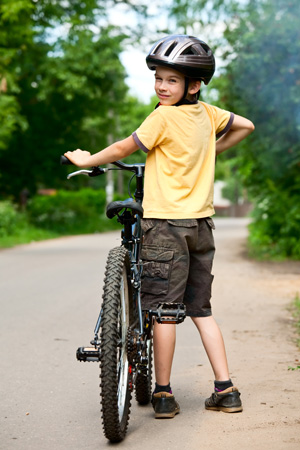
Recreational injuries to children occur most often while riding a bike.
Safety tips for riding a bike:
- Adults should always supervise children who are riding bicycles.
- Give your kids a sufficient amount of practice time with training wheels before allowing them to ride freely.
- Helmets - Make sure your helmet meets the standards of the Consumer Product Safety Commission (CPSC). A good bike helmet should have a chin strap and should be worn squarely on top of the head without being able to slide around.
- Don't ride at night or on slippery or rough surfaces.
Running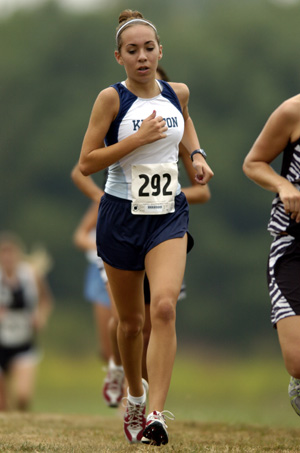
Safety tips for running:
- Shoes should have good shock absorption, stability and cushioning, fit one-half to one full size larger than measured foot when measured before run, late in the day.
- Change shoes after 250-300 miles of use (about every six months if running 10 miles per week).
- Wear loose, breathable clothing in layers, with inner layer made of polypropylene, thermax or other material that pulls perspiration from the skin.
- Carry a whistle, a form of identification and loose change for a phone call.
- Apply p etroleum jelly to areas exposed to cold or to prevent/heal chafing.
Hockey (Ice or field)
Safety tips for playing hockey:
- Helmet/face mask with strap fastened snugly
- Shoulder pads, shin pads, elbow pads, hip pads, and tension pads
- Padded hockey pants, gloves, jersey, mouth guard, athletic supporter if male
- Glasses with safety glass if required by student
Tennis
Safety tips for playing tennis:
- Elbow, wrist or knee supports to absorb shock
- Tennis shoes with adequate support
- Chalk or sawdust to keep handle dry and to prevent hand blisters
- Perspiration bands to maintain visualization
Volleyball
Safety tips for playing volleyball:
- Knee pads
- Defensive pants
- Lightweight footwear with strong ankle and arch support, as well as shock absorption
Basketball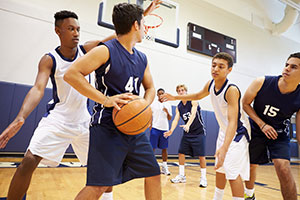
The leading cause of sports-related injuries is basketball. Protective equipment will help reduce the likelihood of experiencing this type of injury.
Safety tips for playing basketball:
- Mouth guards, mouthpieces, and safety glasses - Helps prevent injury to the face and mouth areas
- Ankle braces, strapping and/or taping - Provides support for joints (knees, ankles, wrists, elbows) and reduces the risk of straining or spraining
- Non-skid, supportive shoes and cotton socks
- Knee and elbow pads
Football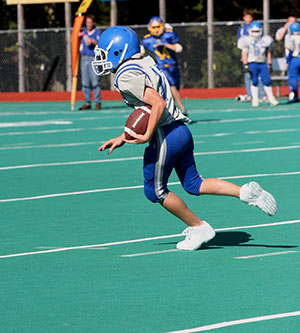
Common injuries that are specific to football include concussions, fractures and sprains.
Safety tips for playing football:
- Drink plenty of fluids before and after playing/practicing.
- Wear proper footwear depending on the surface of the playing field to avoid sliding and falling.
- Avoid tackling with the head/neck.
- Helmets - Protect against head injuries and concussions by always wearing a helmet while playing football.
- Face mask and mouth guard - Helps prevent injury to the face and mouth areas
Roller sports
Hundreds of thousands of cases of broken bones and fractures are reported each year due to roller sports injuries such as roller skating, roller hockey, rollerblading and skateboarding. Rollerblading has grown in popularity over the last several years, with almost 18 million people estimated to participate annually.
 Safety
tips for roller sports:
Safety
tips for roller sports:
- Adults should always supervise children participating in roller sports.
- Avoid roller sports when pavement is slick or rough.
- Wrist guards - Keep wrist joints secure and protect against sprain or strain.
- Helmets - Protect against head injuries and concussions by always wearing a helmet while playing roller skating, rollerblading or skateboarding. Helmets should be worn on the front of the head to protect forehead.
- Knee and elbow pads - Greatly reduce the risk of suffering a knee or elbow injury
- Make sure brake pads are not worn down.
- Fit skates for their specific wearer, taking into consideration their size and ability level.
- Skate boots should fit properly with the heel in the back of the boot, socks (the same thickness as used when trying on the skates).
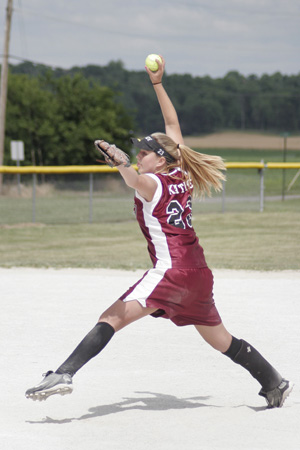
Baseball and softball
An estimated 4.8 million children participate each year in baseball and softball. "Little league elbow" is an overuse injury caused by frequent throwing of the ball, resulting in overstress on the elbow.
Safety tips for playing baseball:
- Batting helmets and face protectors - Polycarbonate face guards protect against injury to the face and teeth.
- Throat guard, long-model chest protector, protective supporter, and shin guards should be worn by catchers to protect the heart, rib cage and other vital organs.
- Players should receive training and coaching that educates them about proper techniques on the playing field.
- Limit the number of pitches per week to 200.
- Incorporate a training program that involves strengthening the rotator cuff and the shoulder muscles.
- Ball considerations - Children ages 5-14 should use low-impact, NOCSAE-approved balls.
- Equipment must fit properly including batting helmet, facial protective devices and specialized mitt, depending on position played.
- Molded cleats
Wrestling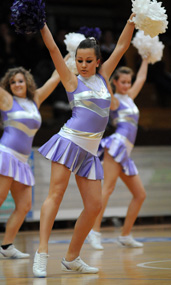
Because wrestling has a high injury rate, safety considerations should receive particular attention. The most common injury associated with wrestling occurs in the knee
Safety tips for wrestling:
- Headgear - Helps protect against injury to the head, ears and face
- Knee and elbow pads - Greatly reduce the risk of suffering a skin, knee or elbow injury
- Athletic supporter with cup for males - Helps protect the groin area
Gymnastics
Safety tips for gymnastics:
- Padded gym floor
- Mats under all equipment
- Hand grips, wrist, ankle, or torso belts, knee, elbow or heel pads as needed
